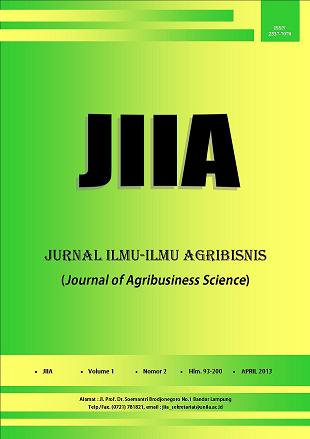ANALISIS KEUNTUNGAN DAN RISIKO USAHATANI TOMAT DI KECAMATAN SUMBEREJO KABUPATEN TANGGAMUS
DOI:
https://doi.org/10.23960/jiia.v1i2.244 Abstract View: 10883
Abstract View: 10883
Abstract
Tomato is one of the considerable potential agricultural products to be developed and cultivated because it has a high nutrition. In addition to its nutrients that are beneficial to health; tomatoes also provide some benefits to consumers, producers, and society. However, the fluctuative price of tomatoes at the producer level could affect the income received by farmers that arouse revenue risk. Therefore, it is necessary to study the farmers’ income and the level of tomato farm risk. The research was conducted in Argopeni Region Sumberejo Subdistrict of Tanggamus Regency. This location was chosen purposively. This research used a survey method in which 56 samples of this research were drawn by a simple random sampling. The analysis tool used for farmers’ income was R/C ratio; while the level of revenue risk was analyzed by calculating the variance, standard deviation and coefficient of variation. The research result showed that the value of R/C ratio was 3.03, it meant that the farming was profitable and viable. Meanwhile, based on the value of the coefficient variation that was 0.86, it showed that there was magnitude of risk faced by farmers and the lower earnings limit of tomato farm was Rp -5.985.235. This showed the amount loss that may be faced by the farmers if there were harm or risk.
Keywords: coefficient variation, lower earnings limt, profit, risk, tomato farm
Downloads
Downloads
Published
How to Cite
Issue
Section
License
Authors who publish with this journal agree to the following terms:
Authors retain copyright and grant the journal right of first publication with the work simultaneously licensed under a Creative Commons Attribution License that allows others to share the work with an acknowledgement of the work's authorship and initial publication in this journal.
Authors are able to enter into separate, additional contractual arrangements for the non-exclusive distribution of the journal's published version of the work (e.g., post it to an institutional repository or publish it in a book), with an acknowledgement of its initial publication in this journal.
Authors are permitted and encouraged to post their work online (e.g., in institutional repositories or on their website) prior to and during the submission process, as it can lead to productive exchanges, as well as earlier and greater citation of published work (See The Effect of Open Access).














